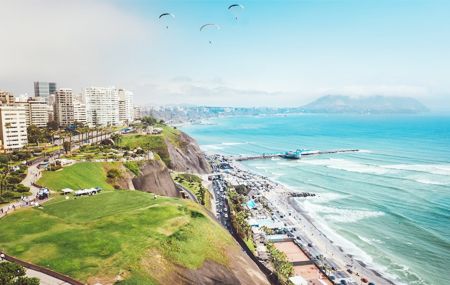
Compare the prices of all rental car companies
Subscribe for exclusive offers and deals!
4.2 / 5
4.2 / 5
Renting a car in Peru is a great way to explore the country and its many attractions. With a car, you'll have the freedom to create your own itinerary and explore the country at your own pace. Peru is home to some of the world's most spectacular sights, including Machu Picchu, the Amazon rainforest and the Nazca Lines. With a car, you can visit these incredible sights and many others with ease. Plus, you'll have the convenience of having your own vehicle, so you can travel with peace of mind.
You'll also benefit from the cost savings of renting a car over other forms of transport. Car rentals in Peru are often much cheaper than flights, buses and other forms of transport. Plus, you'll have the convenience of having your own vehicle, so you won't have to worry about finding public transport or waiting for buses and taxis. So, if you're looking for a cost-effective way to explore Peru, car rental is definitely the way to go.

Other cities worth mentioning include Huaraz, Chiclayo, Iquitos, Puno, and Nazca. Each of these cities has its own unique attractions and experiences to offer, making them great destinations for any traveler to Peru.
Car rental prices in Peru vary depending on the type of car you wish to rent, the length of the rental, and the company you choose. Generally speaking, car rental prices in Peru can be quite affordable, especially when compared to other countries in the region.
For example, a small economy car with a manual transmission can cost around $20-$30 per day, while a luxury car with an automatic transmission can cost around $50-$60 per day. Long-term rentals are also available, and can be as low as $300-$400 per month.
It is important to note that car rental prices in Peru can vary greatly depending on the company you choose. Some companies may offer special deals or discounts, so it is always a good idea to shop around and compare prices. Additionally, it is important to check the terms and conditions of the rental, as some companies may require additional fees for insurance or other services.
Overall, car rental prices in Peru are quite reasonable, and can be a great way to explore the country. With a bit of research and comparison shopping, it is possible to find a rental car that fits your needs and budget.
By following these tips, you can save money on your car rental in Peru. Booking in advance, comparing prices, looking for discounts, checking for additional fees, and opting for a smaller car can all help you get the best deal on your car rental.
Driving in Peru is subject to the same rules and regulations as driving in other countries, and drivers must obey all traffic laws and regulations. Drivers must carry a valid national driver's license, a valid passport, and proof of vehicle registration. The speed limit on highways is 80 km/h and 50 km/h in urban areas. It is illegal to drive with a blood alcohol content of more than 0.05%, and it is also illegal to use a cell phone while driving. Drivers must always drive on the right side of the road, and seatbelts must be worn at all times.
The following questions and answers are a selection of the most popular questions for Peru. If you do not find the answer to your question, have a look at the Frequently Asked Questions page or contact us.
In Peru, there are a variety of parking options depending on the city you are visiting. In the larger cities, such as Lima, there are many parking garages and lots that offer short and long-term parking. There are also street parking spots that can be found throughout the city, although these are often more expensive and harder to find. In smaller cities and towns, there are usually fewer parking options. However, you may be able to find street parking or small parking lots. It is important to be aware of the parking regulations in the city you are visiting, as some areas may have restrictions or require permits.
Yes, there are toll roads in Peru and they are managed by the National Superintendence of Sanitation Services (SUNASS). The tolls are paid at toll booths located along the roads and vary depending on the length of the route. Generally, the tolls are paid in cash, although some toll booths accept credit cards. In addition, some toll booths offer discounts for frequent travelers or those with special permits. The tolls are usually collected at the end of the trip, although some roads require payment at the beginning of the trip.
In Peru, they drive on the right side of the road.
The currency in Peru is the Sol (PEN).
The time zone in Peru is Eastern Standard Time (GMT-5). Peru does not observe Daylight Saving Time, so the time zone remains the same throughout the year.
The official spoken language in Peru is Spanish. Spanish is the official language of Peru and is spoken by the majority of the population. The Peruvian Spanish language is unique and has its own distinct dialect and accent. Quechua and Aymara are also spoken by some indigenous populations in Peru. Additionally, there are over 13 other native languages spoken in Peru.
[EST] Mon - Fri: 03:00 - 16:00 Sat - Sun : 03:00 - 11:00
[GMT] Mon - Fri: 08:00 - 16:00 Sat - Sun : 08:00 - 16:00
Mon - Fri
Sat - Sun
03:00 - 16:00
08:00 - 16:00
[EST]
[GMT]
03:00 - 11:00
03:00 - 16:00